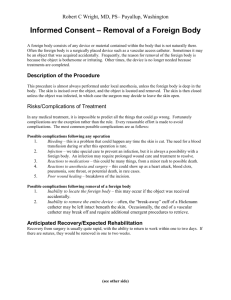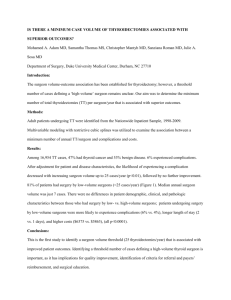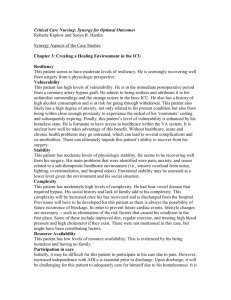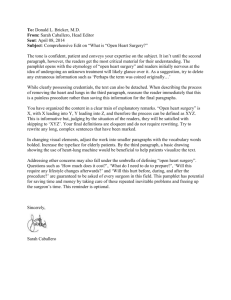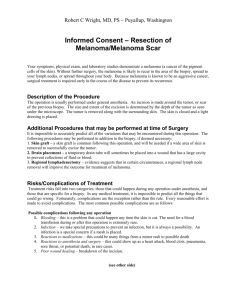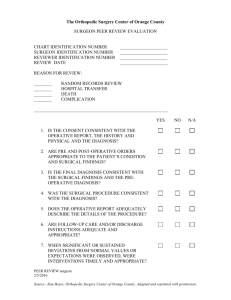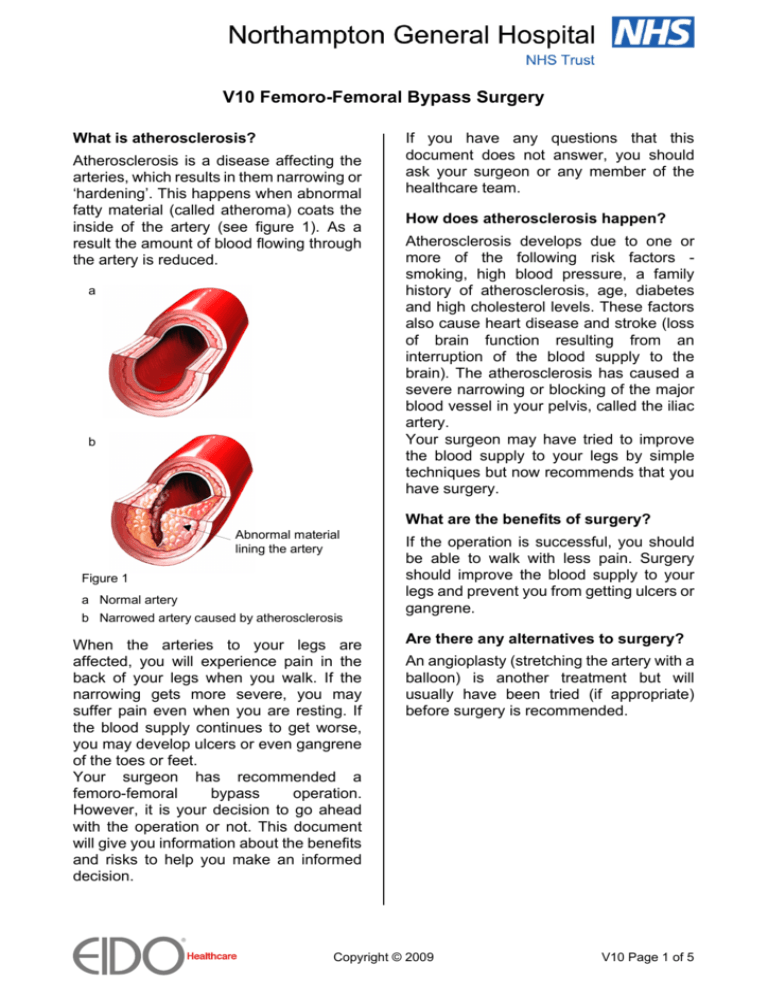
V10 Femoro-Femoral Bypass Surgery
What is atherosclerosis?
Atherosclerosis is a disease affecting the
arteries, which results in them narrowing or
‘hardening’. This happens when abnormal
fatty material (called atheroma) coats the
inside of the artery (see figure 1). As a
result the amount of blood flowing through
the artery is reduced.
a
b
If you have any questions that this
document does not answer, you should
ask your surgeon or any member of the
healthcare team.
How does atherosclerosis happen?
Atherosclerosis develops due to one or
more of the following risk factors smoking, high blood pressure, a family
history of atherosclerosis, age, diabetes
and high cholesterol levels. These factors
also cause heart disease and stroke (loss
of brain function resulting from an
interruption of the blood supply to the
brain). The atherosclerosis has caused a
severe narrowing or blocking of the major
blood vessel in your pelvis, called the iliac
artery.
Your surgeon may have tried to improve
the blood supply to your legs by simple
techniques but now recommends that you
have surgery.
What are the benefits of surgery?
Abnormal material
lining the artery
Figure 1
a Normal artery
b Narrowed artery caused by atherosclerosis
When the arteries to your legs are
affected, you will experience pain in the
back of your legs when you walk. If the
narrowing gets more severe, you may
suffer pain even when you are resting. If
the blood supply continues to get worse,
you may develop ulcers or even gangrene
of the toes or feet.
Your surgeon has recommended a
femoro-femoral
bypass
operation.
However, it is your decision to go ahead
with the operation or not. This document
will give you information about the benefits
and risks to help you make an informed
decision.
If the operation is successful, you should
be able to walk with less pain. Surgery
should improve the blood supply to your
legs and prevent you from getting ulcers or
gangrene.
Are there any alternatives to surgery?
An angioplasty (stretching the artery with a
balloon) is another treatment but will
usually have been tried (if appropriate)
before surgery is recommended.
Copyright © 2009
V10 Page 1 of 5
What will happen if I decide not to have
the operation?
Your doctor will make sure that you are on
blood-thinning medication and that the risk
factors for this disease, such as high blood
pressure, diabetes and high cholesterol
levels, are treated. You will also be
advised to stop smoking, as this is
essential to prevent your leg from getting
worse.
The blood supply may continue to get
worse resulting in gangrene. As a result,
your leg or foot may need to be amputated.
Blocked
iliac
artery
Bypass
graft
Figure 2
Graft in place which bypasses the blockage
What does the operation involve?
The healthcare team will carry out a
number of checks to make sure you have
the operation you came in for. You can
help by confirming to your surgeon and the
healthcare team your name and the
operation you are having.
A variety of anaesthetic techniques are
possible. Your anaesthetist will discuss the
options with you and recommend the best
form of anaesthesia for you. You may also
have injections of local anaesthetic to help
with the pain after surgery. Your surgeon
or anaesthetist may give you antibiotics
during the operation to reduce the risk of
infection. The operation usually takes
between forty minutes and two hours.
Your surgeon will make a cut in both your
groins over each common femoral artery.
Your surgeon will stitch a bypass graft onto
both common femoral arteries. Blood will
then be able to flow through the graft,
bypassing the blocked iliac artery (see
figure 2).
The graft is usually artificial. Your surgeon
will discuss this with you.
At the end of the operation, your surgeon
will close the skin with stitches or clips.
What should
medication?
I
do
about
my
You should make sure your surgeon
knows the medication you are on and
follow their advice.
You may need to stop taking warfarin,
clopidogrel (Plavix) or aspirin before your
operation.
If you are a diabetic, it is important that
your diabetes is controlled around the time
of your operation. Follow your surgeon’s
advice about when to take your
medication.
If you are on beta-blockers to control your
blood pressure, you should continue to
take your medication as normal.
Copyright © 2009
V10 Page 2 of 5
What can I do to help make the
operation a success?
• Lifestyle changes
If you smoke, you must try to stop smoking
now. Smoking is one of the main reasons
why this problem happens.
Stopping smoking now can help reduce
the risk of you suffering a heart attack,
having further narrowing of the arteries
and developing certain cancers. Stopping
smoking several weeks or more before an
operation may reduce your chances of
getting complications and will improve your
long-term health.
For help and advice on stopping smoking,
go to www.smokefree.nhs.uk.
You have a higher chance of developing
complications if you are overweight.
For advice on maintaining a healthy
weight, go to www.eatwell.gov.uk.
• Exercise
Regular exercise can reduce the risk of
heart disease and other medical
conditions, improve how your lungs work,
boost your immune system, help you to
control your weight and improve your
mood. Exercise should help to prepare you
for the operation, help with your recovery
and improve your long-term health.
For information on how exercise can help
you, go to www.eidoactive.co.uk.
Before you start exercising, you should ask
a member of the healthcare team or your
GP for advice.
What complications can happen?
The healthcare team will try to make your
operation as safe as possible. However,
complications can happen. Some of these
can be serious. You should ask your
doctor if there is anything you do not
understand. Any numbers which relate to
risk are from studies of people who have
had this operation. Your doctor may be
able to tell you if the risk of a complication
is higher or lower for you.
The complications fall into three
categories.
1 Complications of anaesthesia
2 General complications of any operation
3 Specific complications of this operation
1 Complications of anaesthesia
Your anaesthetist will be able to discuss
with you the possible complications of
having an anaesthetic.
2 General complications
operation
of
any
• Pain, which happens with every
operation. The healthcare team will try to
reduce your pain. They will give you
medication to control the pain and it is
important that you take it as you are told so
you can move about as advised.
• Bleeding during or after surgery. This
may need a blood transfusion or another
operation. It is common to get bruising
around the cuts.
• Infection of the surgical site (wound).
To reduce the risk of infection it is
important to keep warm around the time of
your operation. Let a member of the
healthcare team know if you feel cold. In
the week before your operation, you
should not shave the area where a cut is
likely to be made. After your operation, you
should let your surgeon know if you get a
temperature, notice pus in your wound, or
if your wound becomes red, sore or
painful. An infection usually settles with
antibiotics but you may occasionally need
another operation. Infection may lead to
the graft failing (risk: 1 in 20).
• Unsightly scarring of the skin.
• Blood clots in the legs (deep-vein
thrombosis), which can occasionally move
through the bloodstream to the lungs
(pulmonary embolus), making it difficult for
you to breathe. The healthcare team will
assess your risk. Nurses will encourage
you to get out of bed soon after surgery
and may give you injections, medication or
special stockings to wear.
Copyright © 2009
V10 Page 3 of 5
3 Specific complications
operation
of
this
• Graft failure due to a blockage. This
can happen quite early after the operation
or months or years later (risk: 1 in 2 after 5
years).
• Infection at the bypass graft join,
which can cause a false aneurysm (risk: 1
in 40). This is a potentially dangerous
swelling and may need a further operation
to repair. The graft may be coated with an
antibiotic to reduce the risk of infection.
Having a bath or shower before your
operation to wash your abdomen and
groins can also reduce this risk.
• Swelling of the leg. This is normal and
usually settles with time.
• Blocking (embolus) of one of the
smaller arteries to the foot. This can
happen if any of the abnormal material
caused by atherosclerosis passes through
the bloodstream and blocks one of the
smaller arteries.
• Amputation. This may be needed if the
bypass fails or if there is infection.
• Fluid collecting under the wound
(seroma), which leads to a continued leak
from the wound (risk: 1 in 200). This
usually settles with time.
• Nerve injury. Small nerves to the skin
can be cut, causing patches of numbness
around the wound or down the leg. This
may be permanent but usually settles with
time.
• Death (risk: 1 to 2 in 20 within 30 days
after the operation). People who need the
operation often have other serious medical
problems.
How soon will I recover?
If you are worried about anything, in
hospital or at home, contact a member of
the healthcare team. They should be able
to reassure you or identify and treat any
complications.
• Returning to normal activities
Your surgeon will tell you when you can
return to work depending on the extent of
surgery and your type of work.
Regular exercise should help you to return
to normal activities as soon as possible.
Before you start exercising, you should ask
a member of the healthcare team or your
GP for advice.
Do not drive until you are confident about
controlling your vehicle and always check
with your doctor and insurance company
first.
• The future
Most people can return to normal activities.
Your surgeon will advise you to have
treatment with blood-thinning medication
such as aspirin or clopidogrel to make the
graft last longer.
Summary
Narrowing of the arteries in the legs is a
common
condition
caused
by
atherosclerosis. You may benefit from
surgery if you have severe disease, and
non-surgical treatment has failed to
improve the blood supply to your legs.
Surgery is usually safe and effective.
However, complications can happen. You
need to know about them to help you make
an informed decision about surgery.
Knowing about them will also help to
detect and treat any problems early.
• In hospital
After the operation you will be transferred
to the recovery area and then to the ward.
You will be able to drink after you have
recovered from the anaesthetic. You will
be given painkillers to control the pain and
keep you comfortable. You should be able
to go home after about three to five days.
However, your doctor may recommend
that you stay a little longer.
Copyright © 2009
V10 Page 4 of 5
Further information
Local information
• NHS smoking helpline on 0800 022 4
332 and at www.smokefree.nhs.uk
• www.eatwell.gov.uk – for advice on
maintaining a healthy weight
• www.eidoactive.co.uk – for information
on how exercise can help you
• www.aboutmyhealth.org – for support
and information you can trust
• Vascular Society of Great Britain and
Ireland at www.vascularsociety.org.uk
• NHS Direct on 0845 46 47 (0845 606
46 47 – textphone)
You can get information locally from:
Acknowledgements
Tell us how useful you found this
document at www.patientfeedback.org
Author: Mr Bruce Braithwaite MChir FRCS
Illustrations: Hannah Ravenscroft RM and Medical
Illustration Copyright © 2009 Nucleus Medical Art.
All rights reserved. www.nucleusinc.com
...................................................................
...................................................................
...................................................................
You may also find the following links
useful.
• www.patient.co.uk
• www.prodigy.nhs.uk/PatientInformation/
• www.patientopinion.org.uk
• www.northamptongeneral.nhs.uk
• www.npsa.nhs.uk/pleaseask
This document is intended for information
purposes only and should not replace advice
that your relevant health professional would
give you.
V10
Issued December 2009
Expires end of December 2010
www.rcsed.ac.uk
www.asgbi.org.uk
Copyright © 2009
V10 Page 5 of 5

